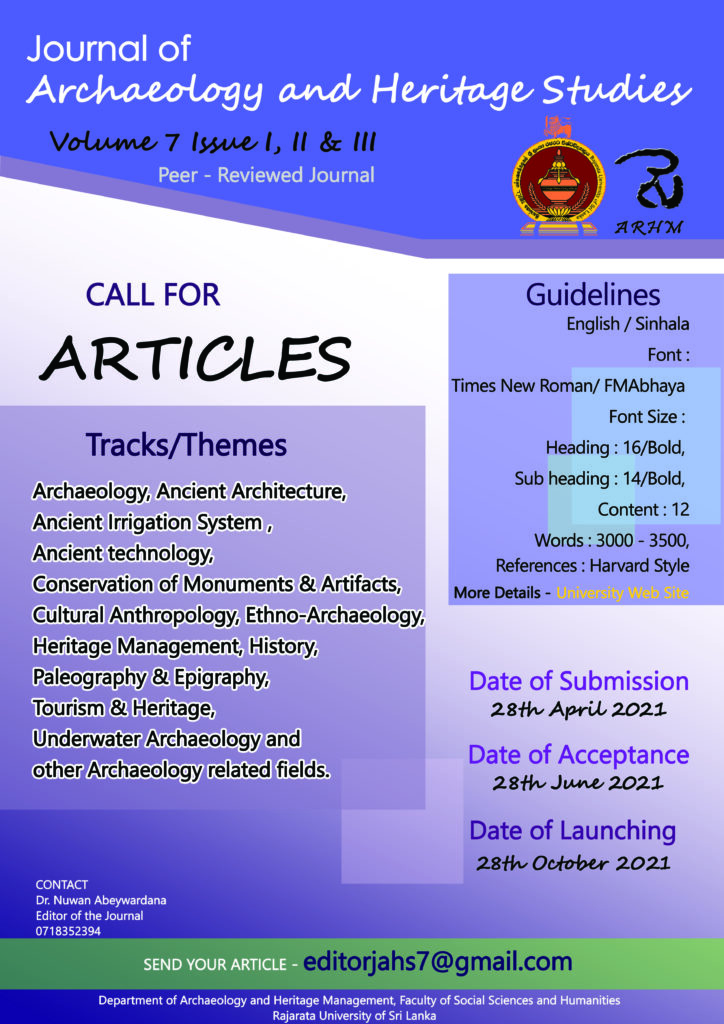General Guidelines
Tracks/Themes:Â Â Â Â Â Â Â Â Archaeology, History, Heritage Management, Conservation of Monuments & Artefacts, Ancient Architecture, Ancient Irrigation System, Ancient technology, Paleography & Epigraphy, Cultural Anthropology, Ethno-Archaeology, Underwater Archaeology, Tourism & Heritage and other Archaeology related fields.
Language:Â Â Â Â Â Â Â Â Â Â Â Â Â Â Â Â Â English / Sinhala
Font:                         English – Times New Roman            Sinhala – FMAbhaya
Font Size: Â Â Â Â Â Â Â Â Â Â Â Â Â Â Â Â Â Heading – 16/Bold, Subheading – 14/Bold, Content – 12
Word Limit:Â Â Â Â Â Â Â Â Â Â Â Â Â Â Words: 3000 – 3500
 Research manuscripts  should comprise:
-
- Front section: Title, Author list, Affiliations, Abstract, Keywords
- Research manuscript sections: Introduction, Materials and Methods, Results, Discussion, Conclusions (optional).
- Back section: Acknowledgments, References.
Front section
- Title:Â The title of your manuscript should be concise, specific, and relevant.
- Author List and Affiliations:Â Must provide Authors’ full first and last names. At least one author should be designated as the corresponding author, and his or her email address and other details should be included at the end of the affiliation section.
- Abstract:Â The abstract should be a total of about 250 words maximum. The abstract should be a single paragraph and follow the style of structured abstracts without headings: 1) Background: Place the question addressed in a broad context and highlight the study’s purpose; 2) Methods: Describe the main methods briefly. 3) Results: Summarize the article’s main findings, and 4) Conclusion: Indicate the main conclusions or interpretations. The abstract should be an objective representation of the article: it must not contain results that are not presented and substantiated in the main text and should not exaggerate the main conclusions.
- Keywords: Three to ten pertinent keywords need to be added after the abstract. They should be specific to the article, yet reasonably common within the subject discipline
 Research Manuscript SectionsÂ
- Introduction: The introduction should briefly place the study in a broad context and highlight why it is essential. It should define the purpose of the work and its significance, including specific hypotheses being tested. Should review the current state of the research field carefully and key publications cited. Finally, briefly mention the main aim of the work and highlight the main conclusions. Keep the introduction comprehensible to scientists working outside the topic of the paper.
- Materials and Methods:Â They should be described with sufficient detail to allow others to replicate and build on published results. New methods and protocols should be described in detail, while well-established methods can be briefly described and appropriately cited.
- Results:Â Provide a concise and precise description of the main results, their interpretation, and the conclusions are drawn.
- Discussion:Â Authors should discuss the results and how they can be interpreted from previous studies and the working hypotheses. The findings and their implications should be discussed in the broadest context possible and the work’s limitations highlighted. Future research directions may also be mentioned. This section may be combined with Results.
- Conclusions:Â This section is not mandatory but can be added to the manuscript if the discussion is unusually long or complex.
Back sectionÂ
- Acknowledgments:Â In this section, you can acknowledge any support given. This may include administrative and technical support or donations in kind
- References: References must be in Harvard style (including table captions and figure legends) and listed individually at the end of the manuscript. We recommend preparing the references with a bibliography software package, such as EndNote, Reference Manager, or Zotero, to avoid typing mistakes and duplicated references.
Preparing Figures, Schemes, and Tables
- File for Figures and Schemes must be provided in a single zip archive and sufficiently high resolution (minimum 1000 pixels width/height, or a resolution of 300 dpi or higher). Standard formats are accepted. However, TIFF and JPEG are preferred.
- All Figures, Schemes, and Tables should be inserted into the main text close to their first citation and must be numbered following their number of appearances (Figure 1, Scheme I, Figure 2, Scheme II, Table 1, etc.).
- All Figures, Schemes, and Tables should have a short explanatory title and caption.
- All table columns should have an explanatory heading. In larger tables, smaller fonts may be used, but no less than 8 pt. in size. Authors should use the Table option of Microsoft Word to create tables.
- Authors are encouraged to prepare figures and schemes in color (RGB at 8-bit per channel).
Important Dates       :
Date of Submission:Â Â Â Â Â Â Â Â Â Â Â Â Â Â Â Â Â Â Â Â Â Â Â Â Â Â Â Â Â Â Â Â Â Â Â Â Â Â Â 28th April 2021
Date of Acceptance:Â Â Â Â Â Â Â Â Â Â Â Â Â Â Â Â Â Â Â Â 28th June 2021
Date of Re-submission of edited articles:Â Â Â Â Â Â 28th August 2021
Date of Launch:Â Â Â Â Â Â Â Â Â Â Â Â Â Â Â Â Â Â Â Â Â Â Â Â Â Â Â Â Â Â Â Â Â Â Â Â Â Â Â Â Â Â Â Â Â 28th October 2021
Articles should be sent to:
Email address –
Postal address-
Editor
Journal of Archaeology and Heritage Studies
Department of Archaeology and Heritage Management
Faculty of Social Sciences and Humanities
Rajarata University of Sri Lanka



